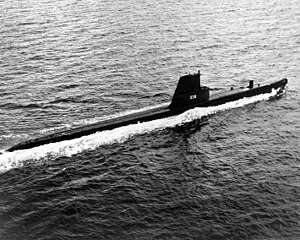USS Catfish (SS-339)
USS Catfish (SS-339), a Balao-class submarine, was a ship of the United States Navy named for the catfish.
 Catfish underway, during her visit to the Far East, 1956. | |
| History | |
|---|---|
| Name: | USS Catfish |
| Builder: | Electric Boat Company, Groton, Connecticut[1] |
| Laid down: | 6 January 1944[1] |
| Launched: | 19 November 1944[1] |
| Commissioned: | 19 March 1945[1] |
| Decommissioned: | 1 July 1971[1] |
| In service: |
|
| Stricken: | 1 July 1971[2] |
| Identification: | SS-339 |
| Fate: | Transferred to Argentina, 1 July 1971[1] |
| Name: | ARA Santa Fe |
| Acquired: | 1 July 1971 |
| In service: | Falklands War |
| Fate: | Captured by British during Falklands War and scuttled |
| General characteristics (As completed) | |
| Class and type: | Balao-class diesel-electric submarine[2] |
| Displacement: | |
| Length: | 311 ft 9 in (95.02 m)[2] |
| Beam: | 27 ft 3 in (8.31 m)[2] |
| Draft: | 16 ft 10 in (5.13 m) maximum[2] |
| Propulsion: |
|
| Speed: | |
| Range: | 11,000 nautical miles (20,000 km) surfaced at 10 knots (19 km/h)[6] |
| Endurance: |
|
| Test depth: | 400 ft (120 m)[6] |
| Complement: | 10 officers, 70–71 enlisted[6] |
| Armament: |
|
| General characteristics (Guppy II) | |
| Class and type: | none |
| Displacement: | |
| Length: | 307 ft (93.6 m)[8] |
| Beam: | 27 ft 4 in (7.4 m)[8] |
| Draft: | 17 ft (5.2 m)[8] |
| Propulsion: | |
| Speed: |
|
| Range: | 15,000 nm (28,000 km) surfaced at 11 knots (20 km/h)[8] |
| Endurance: | 48 hours at 4 knots (7 km/h) submerged[8] |
| Complement: |
|
| Sensors and processing systems: |
|
| Armament: |
|
U.S. Navy service
Catfish was launched 19 November 1944 by Electric Boat Co., Groton, Connecticut; sponsored by Mrs. J. J. Crowley; and commissioned 19 March 1945, Lieutenant Commander W. A. Overton, USNR, in command.
Catfish sailed from New London 4 May 1945 for Pearl Harbor, arriving 29 June. After training and the installation of new equipment, she proceeded to Guam for special training, then departed 8 August on her first war patrol, a special mission to locate a minefield off Kyūshū. When the cease-fire order was given 15 August, she was ordered to the Yellow Sea for surface patrol and lifeguard duty. She returned to Guam 4 September, thence to the West Coast, arriving at Seattle 29 September.
Based at San Diego, Catfish operated locally on the west coast and made two cruises to the Far East during which she conducted simulated war patrols and provided services to the Seventh Fleet.
Catfish was extensively modernized in a GUPPY II conversion (August 1948–May 1949), giving her greater submerged speed and endurance. She was on another Far Eastern cruise when war broke out in Korea in which area she made a reconnaissance patrol in support of the United Nations forces. Catfish returned to the States 20 October 1950 and was based in San Diego.
After that the submarine carried out training exercises with Naval Reservists off the west coast, operated with the Canadian Forces in joint antisubmarine warfare exercises, and made several cruises to the Far East.
Awards
- Asiatic-Pacific Campaign Medal with one battle star
- World War II Victory Medal
- Navy Occupation Medal with "ASIA" clasp
- China Service Medal
- National Defense Service Medal with star
- Korean Service Medal
- Armed Forces Expeditionary Medal with star
- Vietnam Service Medal with two campaign stars
- United Nations Korea Medal
- Republic of Vietnam Campaign Medal
Argentine Navy service as ARA Santa Fe
Catfish was decommissioned, struck from the Naval Register, and sold to Argentina, 1 July 1971, where she was renamed ARA Santa Fe. In 1982, during the Falklands War Santa Fe was badly damaged and subsequently captured by British forces. Deemed too costly to economically repair as a war prize she was sunk in Grytviken Sound, South Georgia.
References
- Friedman, Norman (1995). U.S. Submarines Through 1945: An Illustrated Design History. Annapolis, Maryland: United States Naval Institute. pp. 285–304. ISBN 1-55750-263-3.
- Bauer, K. Jack; Roberts, Stephen S. (1991). Register of Ships of the U.S. Navy, 1775-1990: Major Combatants. Westport, Connecticut: Greenwood Press. pp. 275–280. ISBN 0-313-26202-0.
- Bauer, K. Jack; Roberts, Stephen S. (1991). Register of Ships of the U.S. Navy, 1775–1990: Major Combatants. Westport, Connecticut: Greenwood Press. pp. 275–280. ISBN 978-0-313-26202-9.
- U.S. Submarines Through 1945 p. 261
- U.S. Submarines Through 1945 pp. 305–311
- U.S. Submarines Through 1945 pp. 305-311
- Friedman, Norman (1994). U.S. Submarines Since 1945: An Illustrated Design History. Annapolis, Maryland: United States Naval Institute. pp. 11–43. ISBN 1-55750-260-9.
- U.S. Submarines Since 1945 pp. 242
- This article incorporates text from the public domain Dictionary of American Naval Fighting Ships. The entries can be found here and here.
External links
- Photo gallery of Catfish at NavSource Naval History